The Hack Armada: Deal or No Deal?
I’ve written a number of stories about selling the 29,000-mile 2008 Silverado HD3500 Duramax diesel duallie that I bought three years ago from my former employer as a mouse-infested mess, resurrected, but rarely used in the way I expected. In the end, it was a ridiculous overkill vehicle for my needs, so in September 2023 I sold it for windfall money, which never happens to me. I don’t regret it one iota. I needed the money far more than I needed the truck.
However, as soon as the truck was gone, I felt its absence. One issue was that I no longer had a vehicle that I could use when I need to drop everything, drive to a well-priced enthusiast car that just showed up online, and tow it home. It didn’t matter that that this was more an emotional issue than a real one (I never once used the Silverado for that in the time I owned it, and the logistics of having to first rent a U-Haul auto transporter makes this ability quite a bit less turnkey than it sounds). It was how I felt. The more realistic issue was that I no longer owned something big that I could use to haul, well, stuff. The tangible examples were trivial—being unable to snag a free king-size Tempur-Pedic mattress and a well-priced workbench. As with towing cars, if I really wanted to do either of these things, I certainly could’ve—I could have rented a truck, or a small U-Haul trailer and towed it behind my little Winnebago Rialta. But again, this had less to do with reality and more to do with feeling that I’d lost a tool that fit my self-image.
So I had another run at it. As I wrote about here, I carefully considered the truck-versus-SUV question, noted that I have no need to haul plywood or 4×8 sheetrock or construction debris or gravel or dirt, and decided that I’d rather have the interior space of a full-sized SUV that can be apportioned to people if need be. At the same time, although I owned six Suburbans to take extended family on beach vacations, I had to admit that in 2024, with my youngest child now 30, the need to carry eight people and coolers and boogie boards onto soft sand is now just a memory.
The requirements for another vehicle shaped up to be:
- Something big enough to swallow, say, a workbench.
- Have a third-row seat because why wouldn’t you want that blade on the Swiss army knife?
- Four-wheel drive so, if needed, Maire Anne or I could have something to drive if the weather turned poor.
- 6500-ish-pound towing capacity (small light cars and a U-Haul auto transporter).
- No exterior rust holes or Check Engine Light (CEL) issues to make it unable to pass Massachusetts state inspection.
- A target budget of around $4000.
- Oh, and I had to not hate it.
The yang to the budget’s yin was the question of how much work I’d be willing to put into the vehicle. One of my “Hack Mechanic’s Tips for Sane Living” is that it’s not a good thing when your daily driver becomes so needy that it’s essentially a project car. While an SUV/stuff hauler wasn’t going to become either my or my wife’s daily, I wanted it to be a tool, not a project. That reinforced my steering clear of well-priced Suburbans, as the ones I saw advertised cheaply needed to have brake lines replaced or had reported shifting issues or lifter noises. I also had no desire to go German, as despite my love for BMWs, few things are as needy as a depreciated high-mileage German V-8. So no BMW X5 4.4s. No Porsche Cayennes. And hell no, no VW Toureg V10 TDIs.
Lastly, regarding fuel economy, there’s no escaping the physics of a 6000-ish-pound, full-sized SUV with a 300-horsepower V-8 for decent towing capacity. Some are better, some are worse, but fueleconomy.gov lists the combined gas mileage of most full-sized SUVs as in the mid-teens. And none of them are like the Tardis on Doctor Who—none are bigger on the inside. If you want cavernous cargo-and-people space, it adds size and weight, which drops gas mileage.
Having owned a string of Chevys, I decided that this go-round I wanted to try to eat from the Japanese buffet. I zeroed in on Toyota Sequoias due to their excellent frequency-of-repair record, but as I wrote about here, the first-generation Sequoias have frame-rot issues so bad that Toyota issued a recall, and here in New England, the ones that have had their frame replaced also rot in other places. Plus people still want a lot of money for them. Looking outside the rust belt didn’t make sense to me, as you pay a premium for the car and a second one for the shipping. That’s something I’d entertain for an enthusiast car, but not for a tool. While the second-gen Sequoias appear to be clear of the frame-rot issue, the asking price for cars with 200,000 miles appears to start near nine grand, and that was more than twice what I wanted to spend.
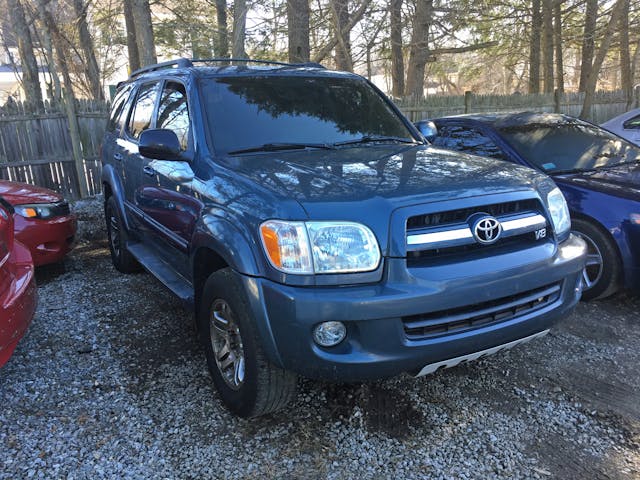

So I somewhat reluctantly honed in on Nissan Armadas, Nissan’s full-sized SUV based on the Titan F-Alpha platform (and yes, I’m aware of the joke “The “R” in “Nissan” stands for “Reliability” ”). At 207 inches—about 17.25 feet—Armadas are about the same size as the Sequoia, about 6 inches longer than a 2008 Tahoe, and about a foot shorter than a 2008 Suburban. And there are a lot of used ones out there for a wide range of prices. However, there are some concerning commonly-listed problems on sites like RepairPal and CarComplaints including a vexing braking issue (the ABS switching on and the booster failing while driving). There are multiple threads about it on the Armada forum (ClubArmada) that discuss the failure of the delta brake stroke sensor and the resulting class action settlement for 2004–08 Armadas and Titan trucks. Armadas had a minor facelift for 2008, and it’s unclear whether that marked the end of the braking issue. To be safe, I resolved to look for a 2009 or later vehicle, but if you’re aiming at a price point and looking within a radius, bottom-feeders can’t be choosers. I did rule out a well-priced 127K 2005 Armada in southern Connecticut because the CarFax showed six owners, the kind of thing I could imagine intermittent brake failure being responsible for.
For a number of reasons, one Facebook Marketplace ad kept tugging at me: “Snow ready! 4-wheel drive 2008 Nissan Armada LE good tires, heated seats, heated steering wheel, power windows, locks, rear gate, leather, DVD entertainment, power folding third row seats. 183,000 miles. Great family car. We bought a new car. $4500 OBO.” The photos showed an intact shiny black Armada with a black leather interior. I don’t like fully murdered-out cars, so I was glad that the wheels were mercifully standard alloys. And there was something about the combination of the black leather and the satin-finish wood trim that called to me.
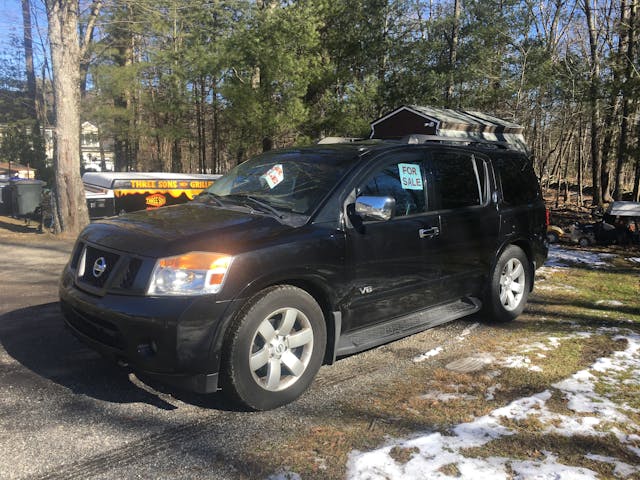
When the seller dropped the asking price to $4000, I asked for the VIN so I could run the CarFax as well as run it through a Nissan VIN decoder to see what options it had.
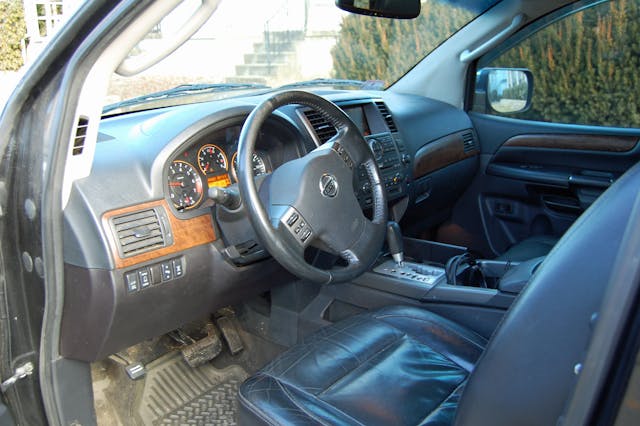
The CarFax was clean and showed that the seller was the fourth owner. He’d bought it the summer of 2022 and had pulled it off the road this past fall because his wife’s car died, they bought a new Tahoe, and they swapped the plates off the Armada. However, the last entry in the CarFax was concerning—“Mechanical issue reported, vehicle towed.” I asked the seller, and he laughed. “I ran out of gas,” he said. The VIN decoder showed that the car had the tow package, which includes a 9100-pound tow capacity, heavy-duty radiator, re-mapped shift points, rear self-leveling suspension, and shorter-geared differential (3.36 as opposed to 2.94 for the non-tow-package).
The seller and I exchanged more messages, I liked what I heard, so I drove the 50 minutes from West Newton down to Mendon, Massachusetts, to see it.
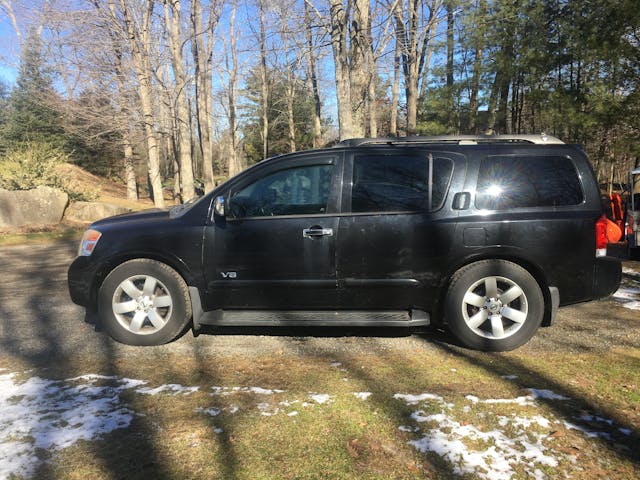
The Armada and I sized one another up as I did my walk-around and crouch-down inspection. When I opened up the right rear door, I found some hidden rust, including an actual hole, at the back corner of the door sill. “Here we go,” I thought, recalling the Sequoia I looked at a few weeks ago where holes behind the running board proved to the tip of the rust-berg. However, this was the only rust-through I found anywhere on the car. I crawled under it as best I could on the dirt-and-gravel driveway, examined the frame, floor, and trailing arms, and saw the more-than-surface-rust-but-less-than-rust-holes expected of a 16-year-old, 183K, lifelong New England car, but nothing worse.
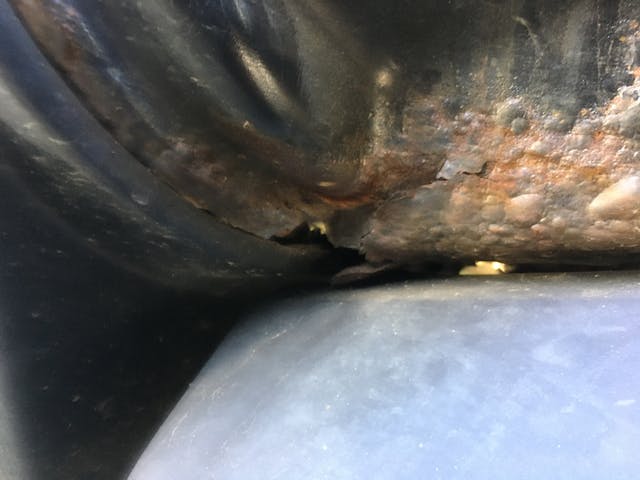
I started the car and saw that the Check Engine Light (CEL) was lit. I connected a code reader and found an active “Catalyst system efficiency below threshold” code for bank 2, and a stored code for bank 1. I cleared them to see what would happen when I drove it.
The fact that the car was unregistered and uninsured meant that the only test-drive I could take was a low-speed spin on local roads. Fortunately, the town of Mendon is pretty rural. I carefully drove the car maybe three miles, not exceeding 30 mph. The brakes were initially poor due to the rotors having rusted from sitting outside, but with several stands on the pedal, they began to come back to life. A few speed bumps revealed that the front shocks were likely gone, but other than that, the car ran, drove, and shifted fine. I verified that the 4WD worked. The CEL did not re-light.
When I parked the car at the end of the test drive, I held my gloved hand over the tailpipe. If an exhaust is completely tight, it should push your hand off, but I didn’t even feel any pressure. Clearly the exhaust had a good-sized hole in it, but it wasn’t in the least throaty, which was good—the hole was probably after the cat and muffler. I skooched back under to try to find it, but the uneven gravel driveway impeded my automotive spelunking. I then carefully used my ungloved hand to feel all four wheels to check for sticking calipers. The left front wheel felt just a bit warmer than the right, but it was subtle.
Well, then.
I was interested, so I asked the question that has served me well for years: “What do you need to get for it?” The guy thought about it, and said “$3500. Less than that and it feels like I’m giving it away.” I had cash in my pocket, but the fact that I hadn’t taken a real test drive at highway speeds meant that anything else could be wrong with it—it might not shift into fifth, the diff could whine, it could have a bad wheel bearing, the brakes could pull at speed, on and on. I also wanted to know if the CEL would re-trigger on a longer drive. All of that meant risk, and I explained that I needed to think what that was worth to me. So I left without making an offer.
Two miles down the road I thought, “This is stupid, because what’s going to happen is that when you think about it, you’re going to decide that it’s $500 worth of risk and offer him three grand. He’ll counter with $3250, you’ll accept, and you’ll need to drive back down to pay him and get the title, and then drive back a third time with plates to pick up the car [my tolerance for driving uninsured cars where, if something goes sideways, I could lose my house, is very low]. Why not just cut to the chase now?” But something in me wanted to consider this all very carefully, so I kept driving home.
That evening, I ran over my thought process again. Yes, I wanted a tow/stuff-hauling vehicle. Yes, it should be a full-sized SUV and not a truck. Yes, this go-round it should be Japanese. And hell yes, the budget was important because there was no sense in spending real money for something neither my wife nor I would daily drive; whatever I bought was likely to sit 90 percent of the time. It didn’t really need to be much. This one fit the bill and was within easy striking distance. I could buy it and be done with it.
I’ve long said that I think about automotive risk differently than most people. In the collector car world with online click-bid-buy sites, there’s the conception that risk is low when things get bid up because the car looks like new and there are a lot of eyeballs on it. Me, I think that if I spend $40,000 on a car and I’m half wrong about it (condition, provenance, mileage, whatever), that’s $20,000 worth of risk. In contrast, a car like this I could buy in the low-$3000 range had almost no risk. It ran and drove well and needed a little work, the exact amount of which was in the noise. If it wasn’t what I expected, I could bail out of it easily.
I called the seller and offered him three grand. He said he wanted to think about it.
Ten minutes later he texted me “How about $3250?”
Done. I’m either the smartest man or the dumbest, right?
The next day I drove back down, paid him, picked up the title, drove to my insurance agent’s office, and insured and registered the car. The day after that, my wife drove me back down to Mendon (for the third time, but hey, with a 50-minute drive, that’s no sweat), I picked up the Armada, and drove it home. The CEL did re-light on the drive home (and it’s a different code—“system performance bank 1”), but other than that it was fine. It was more than fine—it’s clearly a far more appropriate vehicle for me than the Silverado, which had the turning radius of a U-boat.
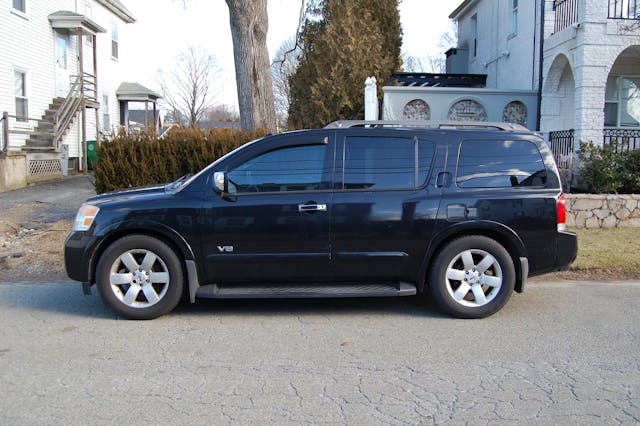
Yesterday I crawled under the car in my driveway and found that the exhaust leak is coming from a really badly welded joint between the muffler and tailpipe. I have an appointment with a muffler shop to see if they can splice it. I’ll get that fixed before I dive into the CEL issue, which may not even matter for vehicle inspection since the 16-year-old car is past the 15-year cutoff for emissions testing. I’m scouring ClubArmada to get information on which front struts to order. So, despite what I said about not wanting a truck that’s a project car, that’s what it’s going to be for a little while. And that’s OK.
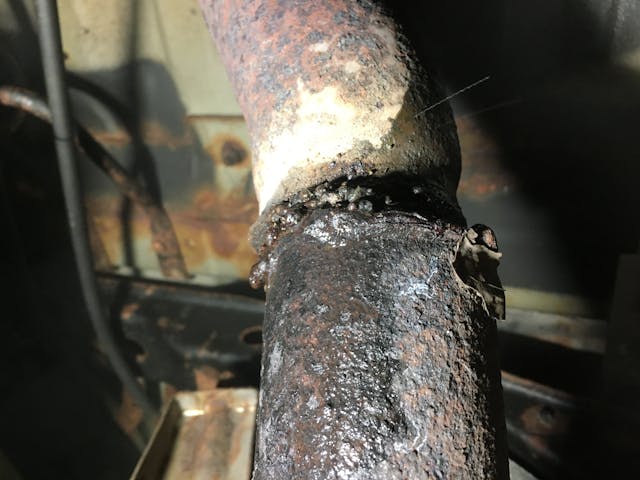
This morning I spent 20 minutes in the Armada’s driver’s seat with the owner’s manual. This thing has more bells and whistles than a hundred clones of Bobby McFerrin in Notre Dame. It’s my first car with BlueTooth, an in-dash information display (yuck), nav system (which I’ll never use), and a back-up camera. It has an 11-speaker Bose sound system. Front and rear sonar. Power rear gate and rear seats. And that DVD entertainment system my kids would’ve loved on the way to the beach vacations in the Suburbans 15 years ago.
Hopefully, I’ll soon go back to doing what I said I needed a big vehicle for—hauling home cool enthusiast cars. And doing so in a single unaccompanied bag-and-drag trip, not two. And certainly not three. Though its first trip will likely be to drag home a workbench.
But there’s one thing bothering me.
Didn’t Cortés burn his Armada?
***
Check out the Hagerty Media homepage so you don’t miss a single story, or better yet, bookmark it. To get our best stories delivered right to your inbox, subscribe to our newsletters.
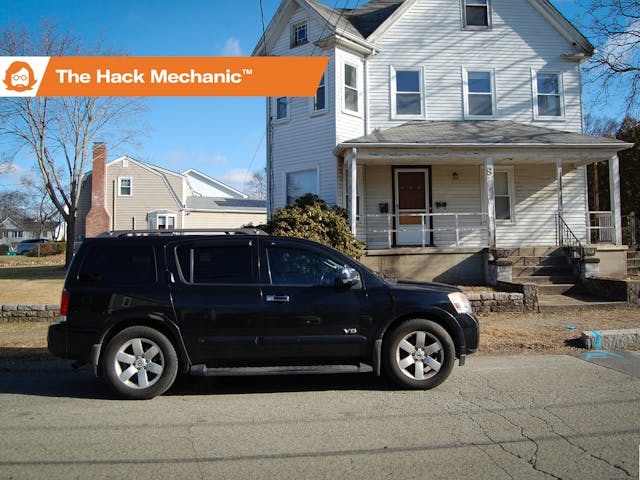


Other than the confusing CEL mysteries, everything else sounds pretty minor and easily fixed (or, frankly, ignorable). Chances are good that the CEL will also prove to be less-than-earth-shattering. Given the fairly narrow strata you had established to look at, finding something that didn’t have AT LEAST this much stuff would’ve been almost a miracle. I’d say you made a good deal for something that will meet your needs, Hack. Looking forward to reading updates as you work your way through the initial – and temporary – project phase and into stories of how the new ride will meld into your life!
Agree. My 2015 Frontier is closing in on 100k. ZERO issues. Fluids & tires is it. Not even brake pads yet. A tow truck YouTuber says that late model Chevy trucks are his #1 customers for break-downs right now.
Between rust and lack of cheap parts the Asian meal here will comeback in heartburn.
Can’t beat a Tahoe or Yukon.
You got that right! I just sold a 02 Avalanche with 240K on the odometer, unbelievably reliable (bought it new and never had any issues with it)…So hard to beat a early 2000ish GMC 5.3 with the cast iron block and no active fuel management….a good friend has a 03 Tahoe with almost 300K on it, same story- just keeps going with no issues…
RockAuto has plenty of cheap parts to keep the old Armada on the road.
Congrats on the totally-not-a-project tow rig!
The codes are probably more related to the O2 sensors on the high mileage rig than the cats. Plugged cats tend to give you performance issues and make weird exhaust noises as the gases try to escape any way they can (often the EGR system, makes a whitling noise from my experience).
One last note I’ll drop is that a V6 Touareg or Cayenne would’ve probably served you well. Those rigs all had 7700lbs of towing regardless of what pony mill hides under the hood, and the VR6 is neigh invincible. The V6 doesn’t like towing as a main duty, but you’re not looking to tow an RV trailer across state lines. You’re pulling home wayward rides on rare occasion.
Rob, your criteria are about the same as mine. My kids are taller than me so I need the leg room of the Suburban over the Tahoe, and I need to be able to tow. But the GMT800s all have rust problems almost or as bad as the Toyotas of that era.
While I have never strongly liked Nissans trucks, I have to respect their ability to withstand abuse. So if you can find on that hasnt been abused to badly…
I look forward to reading more about your new purchase 🙂
See you in my 05 XL Denali (my wife’s Xmas present when new). My last kid’s 30 too. I didn’t need the F350 either..or the Stang, or the motorhome or the sleds or the………
Awesome read. I hadn’t considered Armadas before but that tow rating is surprisingly high. They had sort of faded into the background as a generic big SUV of the 2000s in my mental picture.
My sister’s neighbor was considering junking an Armada because it had issues and they were moving overseas. I remote diagnosed it as a blown rear, priced a junkyard replacement, and expressed interest in the truck. It was either my interest or someone else prodding them, but they quickly decided not to junk it… or sell it to me.
Long story, but the point is that in my research, I discovered that differential failure is apparently common in the Nissan full-size trucks… something to keep in mind
The Asian brands just never mastered the full size truck. They have tried to copy and all but never got it right. Same on the large SUV models. The Americans may not be perfect but they are in greater numbers so when or if there is a problem you can fix it for less than the value of the model
Keep it washed and rust will tend to keep away.
Thanks for sharing your research results and rationale. Very helpful to those of us whose youngest is (or will be) 30 this year and are looking to rearrange the fleet! I will not be towing anything home to my urban lot with no garage, but I want to be able to move *stuff* (ouch on missing that TempurPedic, btw). So I bought my mechanic’s daughter’s 2007 Passat wagon (too small for her Cane Corso), 214,000 km (128K miles), without a speck of rust (Vancouver Island life, baby), for CDN$2,000. It should have a timing belt this year, and the autobox is a bit clunky on certain shifts (will start with fluid and filter, and a hard reset), but it is an ideal extra hauler/winter car. A tool, as you say. I cannot quite shake ‘Suburban nostalgia’ myself, nor ‘Westfalia nostalgia’, for that matter, but neither fits into my life now, alas. Good luck the Armada. It should do what you want it to do, and as my kids would tell you, it actually has all the side and curtain airbags a sane person now wants and you will walk away from most crashes (unlike in a pre-2000s Suburban, say).
You’ll do fine with your Armada. Just stay away from anyone named Drake.
Hopefuly the fixes are easy and long lasting. My brother has a Titan pickup of the slightly later vintage and it works great for him.
Whenever I buy an older high mileage vehicle, one of the first things I do is detail the interior. Even though it’s just perception, a clean pleasant interior always makes the car feel worth more, as well as more enjoyable.
Plus it keeps me up at night thinking of how many times that drivers seat had to swallow previous owners farts…
As DUB6 and Binksman requested, I would like to see updates as you get it sorted out also. Always a good read.
I have also read of less-than-robust rear differentials on Nissan trucks, as TG mentioned. Though knowing your attention to PM, I’m sure you’ve already planned for fluid changes on the new tool.
Great read, as always. Keep ’em coming.
Rear differential problems on Titans and Armadas are a known issue. And, keep in mind that CarFax reports can be misleading. I have a 2013 Dodge Grand Caravan, bought it new, and the CarFax report shows that the engine was replaced 2 years ago. It was not, but the shop entered incorrect information.